#stacy nelkin
Text
Hey, people who’ve never seen Get Crazy (1983)—based on the montage below, what would you guess is the plot?
youtube
#sparks#get crazy#malcolm mcdowell#lou reed#robert picardo#daniel stern#allen garfield#gail edwards#ed begley jr.#stacy nelkin#miles chapin#bill henderson#lee ving#john densmore#paul bartel#howard kaylan#mary woronov#jackie joseph#Youtube
2 notes
·
View notes
Text

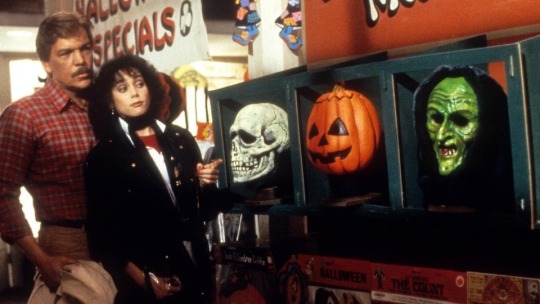




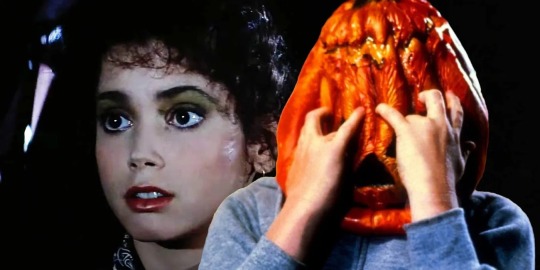
Halloween 3 ( not to be confused with the Micheal Myers Halloween movies is a misunderstood horror movie. Yes the title is misleading but it’s because John Carpenter wanted to do other Halloween themed stories after Halloween 2. Which should’ve been the end of Micheal Myers. The full title is Halloween 3: season of the witch, not to be. Confused with the George A Romero movie made on the 1970s. This story is about a warlock Dan O’Herethy who uses technology and witchcraft to make masks that will literally kill the wearers on Halloween night. A Doctor ( Tom Atkins) and a daughter of a murdered shopkeeper( Stacy Nelkin) go to this town called Santa Mira . Which is under the control of the warlock and his sinister androids. Yes it sounds kind of nuts and doesn’t make a lot of sense. When the people die snakes and bugs crawl and slither out of their faces . Yuck! But then there is that ending that makes you scratch your head. The movie bombed but later became a sort of cult classic. My opinion is they should’ve changed the title to let’s say Night of the warlock or time of the witch. But not Halloween 3 . But then Micheal Myers does make an appearance, during a commercial for the movie Halloween 1978. And after it’s over at 900. We’ll let’s say everyone wearing the masks and watched the big giveaway at 900 is dead. Can the the Dr stop this? Not saying. But here’s a fact the masks shown in the movie; the skull,the witch , and the pumpkin were made by the famous Don Post studios and for an Easter egg in Halloween 2018 and Halloween Kills 2022 , three kids are wearing these masks.
1 note
·
View note
Photo

Halloween III: Season of the Witch (1982)
#Halloween#Season of the Witch#part 3#Tommy Lee Wallace#Tom Atkins#Stacy Nelkin#Dan O'Herlihy#1982#VHS#horror
64 notes
·
View notes
Photo
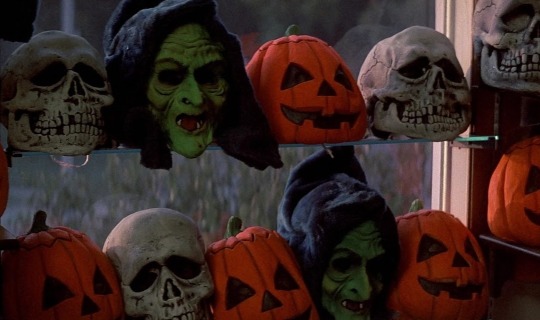
Halloween III: Season of the Witch (1982)
by Tommy Lee Wallace
#1980s movies#slasher#horror#john carpenter#Tom Akins#Stacy Nelkin#dan o'herlihy#mask#witch#pumpkin#skull
2 notes
·
View notes
Photo
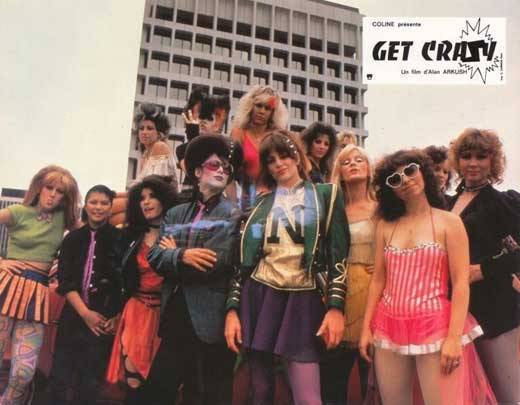
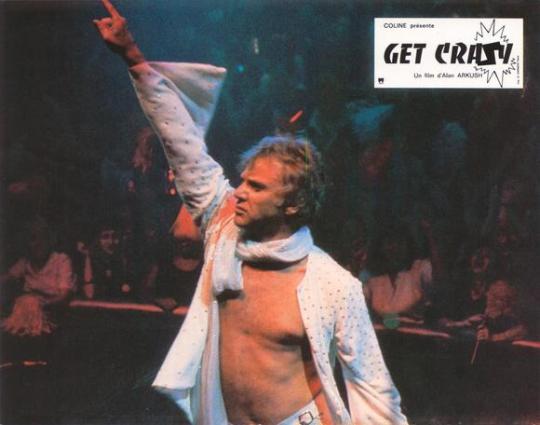


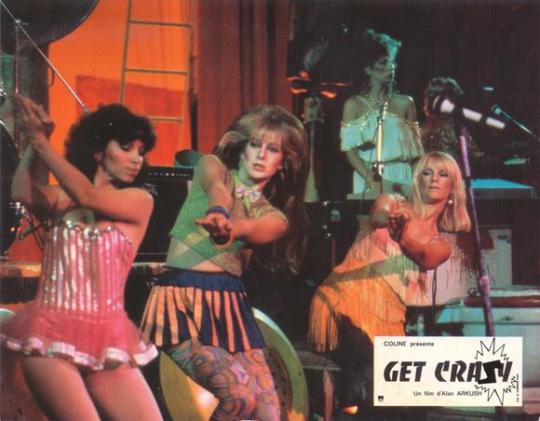
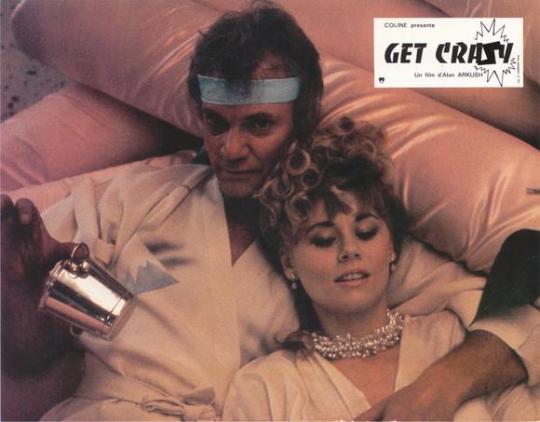


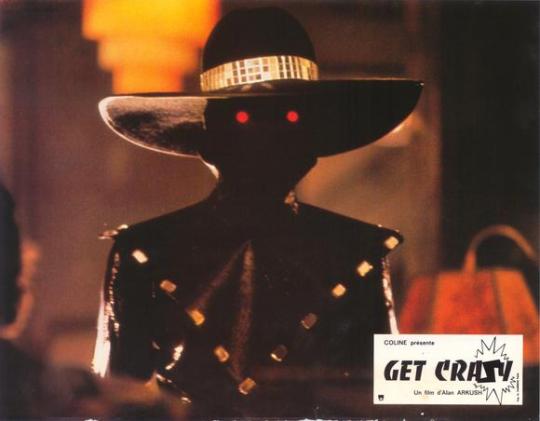
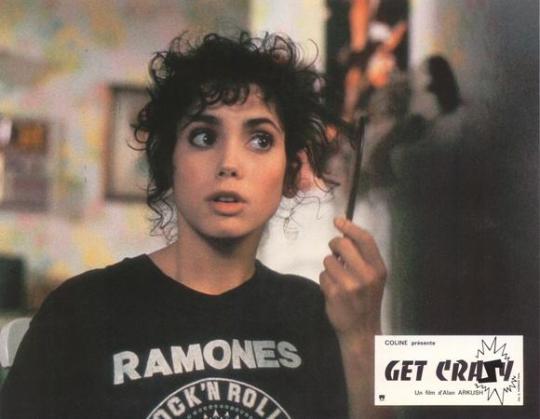
GET CRAZY (1984) Dir. Allan Arkush
#get crazy#malcolm mcdowell#daniel stern#allan arkush#the ramones#sparks#lee ving#fear#punk rock#stacy nelkin#80's punk#80's new wave#new wave#post punk#punk rock movies#80's cult comedies#80's cult movies#80's cult films#movie musicals#britt ekland#gail edwards
13 notes
·
View notes
Text
"WESTWARD HO!": Part Four - "THE CHISHOLMS" (1979)
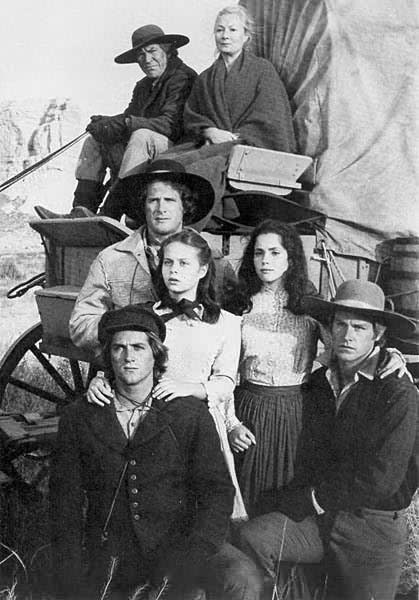
Below is Part Four to my article about Hollywood's depiction about the westward migration via wagon trains in 19th century United States. It focuses upon the 1979 CBS miniseries, "THE CHISHOLMS":
"WESTWARD HO!": Part Four - "THE CHISHOLMS" (1979)
I. Introduction
The 1979 television miniseries, "THE CHISHOLMS" began as an adaptation of Evan Hunter's 1976 novel of the same title. It told the story of a Western Virginia family's trek to California in the mid-1840s.
It began in 1843 with the wedding of Hadley and Minerva Hadley's oldest child, Will. Life for the Chisholm family at their Appalachian farm seemed charmed, until the members suffer a series of misfortunes by the early spring of 1844. Will's new wife died after giving birth to a stillborn child. Hadley managed to alienate the local plantation owner, known as "the Squire", after he terrorized the local preacher for using the wrong Bible passage at his daughter-in-law's funeral. And the family lost a valuable piece of land to an antagonistic neighbor, thanks to Hadley's late older brother. Years earlier, the latter had abandoned the neighbor's sister before a wedding could take place, and willed the land to her as compensation. Stuck with land unfit for farming, Hadley decides to move his family to California.
The Chisholms suffer a few more misfortunes during their trek to California. They discover from a Louisville merchant that they had began their westward trek at least a month too late. They made a second mistake by hiringan Illinois man named Lester Hackett to guide them west. The latter fell in love with Hadley and Minerva's older daughter, Bonnie Sue and ended up getting her pregnant before abandoning the family near St. Louis. Will and middle son Gideon left the family to track Lester to Iowa and ended up serving on a prison work gang for a month, for "trespassing" on the farm of Lester's mother. By the time the family reached the western plains, it suffered a major tragedy, which convinced them to end their journey at Fort Laramie, in present-day Wyoming.
II. History vs. Hollywood
Like "CENTENNIAL", "THE CHISHOLMS" managed to be that rare period drama that managed to be historically accurate . . . or at least 95% accurate. In fact, I was only able to find one topic that struck me as historically inaccurate. And it proved to be minor.
When the Chisholms began their journey from western Virginia to California in 1844, they had left their old cabin in mid-spring. After all, they reached Louisville, Kentucky by May 16 or 17. Most wagon parties usually left Independence, Missouri, the jump-off spot for the western trails by that period. Even the infamous Donner Party left western Missouri sometime between May 16 and May 20 (in 1846). At least two people remarked on their late departure - a Louisville merchant and a saloon keeper in Independence. Aside from Minerva and youngest daughter Annabel, the rest of the Chisholms decided to continue the trek west in the hope of encountering more wagons.
Aside from "CENTENNIAL", "THE CHISHOLMS" is the only production I know that covered a wagon journey east of Missouri. Most movies or television productions usually have wagon parties begin their journey in St. Louis or Independence. The Chisholms' journey included a river journey down the Ohio River aboard a craft similar to the flatboat; the crossing of the Big Blue River; and passing famous landmarks such as Scott's Bluff, Courthouse Rock and Chimney Rock.
Just prior to the Chisholms' westward journey, they acquired a larger wagon through barely fair means (which is another story). Surprisingly, the new wagon proved to be a decent-sized farm wagon, suitable for overland trails and not the lumbering Hollywood favorite - the Conestoga. However, the family not only loaded their wagon with essential goods, but also with furnishings that may have proven to become a burden on the animals pulling it - including a grandfather clock. The Chisholms never dumped any of their non-essentials along the trail. However, Will, Gideon and an Objibwe woman named Kewedinok they had met in Missouri did find several furnishings that had been abandoned by previous emigrants along the trail. The Chisholms used mules to pull their wagon across the continent. However, a lively debate on mules vs. oxen sprung up between Will and Lester Hackett. The family's mules also attracted the attention of a small group of young Pawnee braves, when the family traveled alone.
In the 1979 miniseries, the Chisholms' westbound journey only took them as far as Fort Laramie. A brief, yet brutal encounter with the four Pawnee braves and a family tragedy convinced them to remain and settle on land near the fort. The miniseries' depiction of the emigrants' encounters with Native American seemed pretty realistic and balanced - except in regard to one matter. "THE CHISHOLMS" featured at least three violent encounters between family members and Native Americans. Family patriarch Hadley Chisholm brawled with a middle-aged Chickasaw man inside an Illinois tavern, which ended with the latter being nearly choked to death. And there were the four Pawnee braves who attacked the family (traveling alone) in order to take their mules and the women. A scene before the attack featured a rather funny conference between the four braves, in which they argued on whether or not to attack the family. The surviving brave of the attack discovered the Chisholms' presence at Fort Laramie in the last episode, and convinced a few other braves to help him rob the family's cabin.
But not all of the Chisholms' encounters with Native Americans were violent. The miniseries revealed Kewedinok's back story of how she became a widow, her violent encounter with white trappers in Western Missouri and her eventual meeting with Will and Gideon. The rest of the family became acquainted with former Army scout Timothy Oates and his Pawnee wife during the early leg of their journey, west of Independence. They also met two Kansa couples traveling eastward by foot in an encounter that led to some friendly trading. The same Kansa couples were later killed by whites, aside from one survivor who was found by Will, Gideon and Kewedinok.
I have only one major complaint about the miniseries' depiction of Native Americans. Many white characters such as Hadley Chisholm, Timothy Oates, and the Fort Laramie trader Andrew Blake never hesitate to express concern about Native Americans consuming alcohol. Hadley was the first to claim that "Indians had no business drinking whiskey". One could have easily dismissed Hadley's words as prejudice on his part. But other white characters also expressed the necessity of denying Native Americans any alcohol. I will not deny that alcoholism has been a problem for many Native Americans. However, it has also been a problem for other ethnic groups, including white Americans of Anglo-Saxon, Scottish or Irish ancestry. This was certainly the case in 19th century America. For example, at least two-thirds of the U.S. Army's officer corps were believed to be heavy drinkers. However, many white Americans (and perhaps other groups) tend to view certain certain groups - which included German and Irish immigrants, African-Americans and especially Native Americans - as naturally heavy drinkers, due to their own prejudices. The screenwriters could have simply been conveying the prejudices of these 19th century white men. But the gravity of Timothy Oates and Andrew Blake's words seemed to hint that this particular prejudice still existed by the late 1970s, when this miniseries was made.
Like "CENTENNIAL", "THE CHISHOLMS" managed to adhere a lot closer to historical accuracy than the first two productions featured in this series. And like the 1978-79 miniseries, only one topic seemed to be the result of Hollywood fiction, instead of fact. In the case of "THE CHISHOLMS", it failed to overcome the myth of Native Americans' susceptibility to alcoholism. Otherwise, the mixture of historical fact and literary fiction proved to be well-balanced.
#westward ho#the chisholms#evan hunter#robert preston#rosemary harris#ben murphy#brian kerwin#james van patten#stacy nelkin#susan swift#charles frank#anthony zerbe#jerry hardin#david hayward#sandra griego#billy drago#brian keith#alcoholism#television miniseries#scotts bluff#chimney rock#courthouse rock#fort laramie
0 notes
Photo
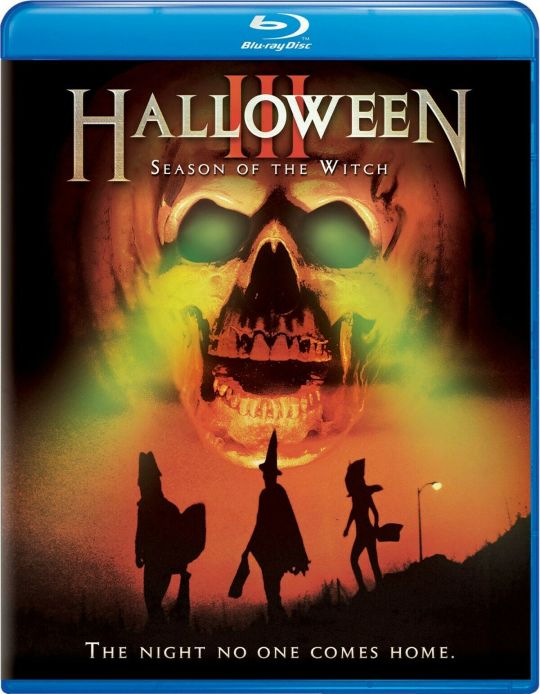
Halloween 3 - Season of the Witch Blu-ray Stacy Nelkin NEW $9.99
http://rover.ebay.com/rover/1/711-53200-19255-0/1?ff3=2&toolid=10039&campid=5337702801&item=123814296363&vectorid=229466 Halloween 3 – Season of the Witch Blu-ray Stacy …
0 notes
Text
Halloween III: The Season of the Witch
#HalloweenIII: #TheSeasonoftheWitch #TomAtkins #StacieNelkin #DanOHerlihy


Year: 1982
Synopsis: A doctor and a young woman work to uncover a conspiracy that threatens the lives of children across the world.
Pros:
• Had an interesting story involving a surreal mix of horror, sci-fi, and fantasy.
• Dr. Dan Challis (Tom Atkins) and Ellie (Stacie Nelkin) were genuinely likable characters in their own ways.
• Conal Cochran (Dan O’Herlihy) succeeded as an engaging cross…
View On WordPress
0 notes
Text
Model says she had AN affair with Woody Allen when she was sixteen - however has 'no regrets'


Model Christina Engelhardt told the Hollywood newsperson she had Associate in Nursing affair with Allen once she was sixteen and he was forty one, and 'I haven't any regrets.'
A Golden State girl says she had a years-long affair with director movie maker that began once she was simply sixteen and he was forty one.
In associate degree interview with the Hollywood communicator, Christina Engelhardt same she became knowledgeable about Allen at his Manhattan lodging whereas she was still sixteen – beneath the legal status of consent in ny – however she doesn’t feel exploited by the moviemaker.
I'm not assaultive Woody," Engelhardt, now 59, told the magazine in associate degree interview printed Mon. "This isn't 'bring down this man.' i am talking concerning my romance. This created ME World Health Organization i'm. i've got no regrets."
She same they were along for eight years, and generally engaged in threesomes with alternative girls, together with histrion Mia Farrow. She same she found the experiences “interesting – a ‘70s exploration.”
Engelhardt – associate degree histrion associate degreed a model – same she was one among the inspirations for the teen character Allen's author character had an affair with in his 1979 show “Manhattan.”
Reps for Allen, 83, and Farrow, 73, failed to answer requests for comment.
Engelhardt isn’t the primary girl to mention she had associate degree affair with Allen whereas in highschool throughout that point frame — histrion Stacy Nelkin has same she did similarly, however that their relationship began once she was seventeen.

Nelkin whom Allen has acknowledged geological dating, has conjointly claimed to be the inspiration for the Mariel writer character in “Manhattan.”
Nelkin told NBC News on Mon that she’d ne'er detected of Engelhardt, however that Allen might need been seeing alternative girls throughout that point amount “doesn’t surprise ME.”
Like Engelhardt, Nelkin remembers her relationship with Allen — whom she same she continues to be shut friends with — warmly.
The time Woody and that i spent along was marvelous and unforgettable. That being same, I actually wouldn’t need either of my daughters thus far somebody twenty four years their senior,” she said.
Engelhardt failed to answer letter of invitation for treat the THR story.
Image Christina EngelhardtChristina Engelhardt attends the 2006 metropolis fete - start - when Party Hosted by LA Confidental Magazine at Writers club Theater in metropolis, California.Michael Bezjian / WireImage/Getty pictures file
Engelhardt told the magazine she was already operating as a model once she caught sight of Allen in known writers’ resort Elaine’s — a brand new royal house town bar and building — in 1976. She same she born him a note at his table along with her sign that scan, “Since you’ve signed enough autographs, here’s mine!”
She same he known as her shortly when and invited her to his avenue apartment, and that they became physically intimate weeks later. She same he ne'er asked her her age, however was aware she was still in highschool.
Engelhardt same Allen unbroken their relationship quiet by invariably having her over to his lodging and ne'er taking her out. She same she had no downside with him business the shots.
I was a entertainer, agreeable," she said. "Knowing he was a director, I did not argue. i used to be returning from an area of devotion."
In the THR interview, Engelhardt same she believes Hemingway’s “Tracy” character relies on a composite of girls, however one among them was her. She conjointly same she’d had no advance warning concerning what the show was concerning.
I cried through most of the show, the dayspring of realization slowly subsidence in as my greatest fears crept to the surface," she wrote during a memoir manuscript she shared with the magazine. "How was our partnership not one thing over simply a fling? we tend to had shared such a special bond right from the beginning, one thing witching, and currently here was his interpretation of ME and North American nation on the large screen for all to determine in black-and-white. however may he interpret my temperament and our life along as if it were just a few fictional creation for art house fatheads to pore over?"
She same that once she next saw Allen, she told him she saw plenty of similarities between Hemingway's character and her. "I thought you'd," she same he responded.
That was it," she wrote in her manuscript. "That was all i might ever get out of him concerning the film, and searching back currently, i'm therefore angry with myself for not being stronger."
She same she eventually left Allen and ny.
I thought i used to be special, so i noticed he is a giant person and he is got a giant life — i am in his life," she said. "It's a rainbow with several colours, and i am one among them."
And whereas she has heat recollections of their time along, she same she was upset when looking for concerning Allen's relationship with Farrow's much-younger adopted girl Soon-Yi Previn.
I felt pitying Mia," she told the magazine. "I thought, 'Didn't Woody have enough 'extra,' with or while not her, that the final thing he had to try and do was to travel for one thing that was whole hers?'
"It was total disrespect," she said.
Allen and Previn are married for twenty one years.
you liked article, this then please subscribe to our YouTube Channel for WordPress video tutorials. You can also find us on Twitter and Facebook.
Read the full article
#1983 woody allen film crossword#1995 woody allen film crossword#barbara christina engelhardt#Christina Engelhardt#christina engelhardt augsburg#christina engelhardt facebook#christina engelhardt fdp#christina engelhardt innsbruck#christina engelhardt instagram#christina engelhardt köln#christina engelhardt kronach#christina engelhardt michael jackson#christina engelhardt oldenburg#christina engelhardt sas#christina engelhardt-uhl#christina maloue engelhardt#christine engelhardt münchen#cristina engelhardt fdp#dr. christina engelhardt#dr. maria-christina engelhardt#dr. maria-christina engelhardt wien#Hollywood#manhattan (woody allen 1979) xvid dvdrip#maria christina engelhardt#Woody Allen#woody allen a documentary#woody allen a rainy day in new york#woody allen actor#woody allen actresses#woody allen age
0 notes
Text
"THE CHISHOLMS" (1979): Chapter II Commentary

"THE CHISHOLMS" (1979): CHAPTER II Commentary
The first episode of the 1979 miniseries, "THE CHISHOLMS" - otherwise known as Chapter I had focused on the Chisholm family's last year at their western Virginia farm. The episode also explored the circumstances that led to patriarch Hadley Chisholm's decision to move the family west to California during the spring of 1844 and their journey as far as Evansville, Indiana. This second episode focused on the next stage of their journey.
This new episode or Chapter II focused on a short period of the Chisholms' migration to California. It covered their journey from southeastern Illinois to Independence, Missouri. Due to the addition of a guide named Lester Hackett, who had agreed to accompany them as far as Missouri, the Chisholm family experienced its first crisis - one that led to a temporary split within the family ranks. The family's journey seemed to be smooth sailing at first. They managed to become used to the routine of wagon train traveling. Lester proved to be an agreeable companion who helped with both hunting for game and cooking. He even managed to save Bonnie Sue Chisholm, who briefly found herself trapped in the family's wagon being pulled away by their pair of skittish mules. Eventually, Bonnie Sue and Lester began expressing romantic interest in each other.
But alas, the family's luck began to fade. A lone rider began trailing the Chisholm party. Lester discovered that he was a friend of someone named James Peabody, who believes Lester was responsible for the theft of some valuables that include a pair of Spanish pistols . . . the same pistols that Lester had claimed he lost in a poker match in Louisville. He and Bonnie Sue enjoyed a night of intimacy together before he abandoned the Chisholms . . . while riding Will Chisholm's horse. Around the same time, Hadley's violent encounter with a drunken Native American at a local tavern fully revealed his deep-seated bigotry towards all Native Americans and foreshadowed the problems it will cause. Then Hadley made one of the worst decisions of his life by allowing Will and middle son Gideon to pursue Lester to Iowa and recover the former's stolen horse.
Upon their arrival in Iowa, Will made an equally disastrous decision. Instead of requesting information and help from the local sheriff, he and Gideon appeared at the Hackett farm, asking for Lester's whereabouts. The two brothers ended up being arrested for the theft of chicken eggs and trespassing. Although the charges of theft were dropped, Will and Gideon were convicted of trespassing and ordered to serve on a prison work gang for a month. This left the rest of the family to continue on to Independence, Missouri - the jump-off point for all westbound wagon trains. During their journey through Missouri, the Chisholms joined with the Comyns, a family from Baltimore. Upon their arrival in Independence, the Chisholms and the Comyns discover that most of the wagons trains had already departed. However, they managed to form a wagon party with a plainsman named Timothy Oates and his Pawnee wife, Youngest Daughter. Unaware that Will and Gideon have been sentenced to a prison work gang, and aware that they are already behind schedule, the Chisholms have no choice but to head west into the wilderness.
For an episode that began in a light-hearted manner, Chapter II ended on a rather ominous note. You know, I have seen this production so many times. Yet, it never really occurred until recently how the turmoil caused by Lester Hackett in this episode ended up causing so much turmoil for the family. What makes this ironic is that it all began with the sexual attraction that had sprung up between him and Bonnie Sue Chisholm back in Louisville. The first sign of this turmoil manifested in Lester's abandonment of the family and especially, his theft of Will Chisholm's horse. The horse theft led to the separation of the family at a time when it would have been more imperative for them to be together as a unit.
Hadley did not help matters by allowing Will and Gideon to search for Lester in Iowa. And the two brothers made the situation worse by failing to immediately contact the local sheriff before appearing at the Hackett farm - an act that led them to be sentenced one month on a prison work gang. Will and Gideon's situation made it impossible for them to catch up with the rest of the family on the trail. And as Beau Chisholm had pointed out to Hadley in Independence, they were not in a position to wait for the other two. The Chisholms had no choice but to leave with two other westbound parties - the Comyns from Baltimore and the frontiersman Timothy Oates and his wife, Youngest Daughter. Two families and a couple does not seem large enough for a safe journey on the overland trail. But considering they were all behind schedule, they could either take the risk continue west or hang around Independence until the next year.
But I did notice that despite all of this turmoil, the light-hearted atmosphere of the episode's beginning seemed to have persisted. More importantly, Chapter II seemed to be marked by a good deal of humor. The episode included humorous moments like Hadley's negative comments about the Illinois and Missouri landscapes, Will and Lester's lively debate over using mules or oxen to pull wagon overland, Lester's attempts to win over the family - especially Minerva, and especially his sexy courtship of Bonnie Sue.
Once Lester had abandoned the family near St. Louis, the humor continued. Will and Gideon's experiences in Iowa were marked with a good deal of sardonic humor. That same humor marked Hadley and Minerva's low opinion of the Comyn family. Even Hadley's quarrel with the Independence saloon owner permeated with humor and theatricality. Looking back on Chapter II, I can only think of two moments that really emphasized the gravitas of the Chisholms' situation - Hadley's violent encounter with the Native American inside an Illinois tavern and that final moment when the family continued west into the wilderness without Will and Gideon.
When the Chisholms left Virginia in Chapter I, their journey was marked with a good number of interesting settings. That episode featured a detailed re-creation of Louisville and travel along the Ohio River. There seemed to be no such unusual settings for Chapter II. The entire episode focused on the family's journey through Illinois, Iowa and Missouri. Not once did the episode featured the family in St. Louis. And a few set pieces (or buildings) served as Independence, Missouri circa 1844.
The performances from Chapter I held up very well. Robert Preston and Rosemary Harris, as usual, gave excellent performances as the family's heads - Hadley and Minerva Chisholm. I was especially impressed by Preston's performance in the scene involving Hadley's encounter with the intoxicated Native American. In it, the actor did a superb job in conveying both Hadley's racism toward all Native Americans and his poignant regret over the tragic circumstances (Allen Chisholm had been killed by a Native American in a drunken fight over a slave woman from the Bailey plantation) behind his toxic attitude. Both Ben Murphy and Brian Kerwin clicked rather well during those scenes that involved Will and Gideon Chisholm's search for Lester. The episode also featured solid performances from James Van Patten, Susan Swift, Katie Hanley (as the amusingly mild-mannered Mrs. Comyn) and David Heyward (as Timothy Oates). Veteran character actor Jerry Hardin gave an excellent performance the slightly proud, yet finicky Mr. Comyn, who seemed to run his life by his pocketwatch.
But if I must be honest, this episode belonged to Stacy Nelkin and Charles Frank, who did superb jobs in conveying Bonnie Sue Chisholm and Lester Hackett's burgeoning romance. I was impressed by how both of them developed Bonnie Sue and Lester's relationship from sexual attraction to playful flirtations and finally, to a genuine romance that was sadly cut short by Lester's need for self-preservation from a charge of theft.
Overall, I enjoyed Chapter II. In a way, it seemed to be the calm before the storm that threatens to overwhelm the Chisholm family on their trek to California. The episode seemed to be filled with a good deal of humor and romance. On the other hand, Lester Hackett's past and current choices in this episode seemed to hint an ominous future for the family by the end of the episode.

#The Chisholms#the chisholms 1979#evan hunter#oregon trail#california trail#Robert Preston#Rosemary Harris#ben murphy#brian kerwin#stacy nelkin#James Van Patten#susan swift#charles frank#jerry hardin#antebellum#david heyward
0 notes
Text
"THE CHISHOLMS" (1979): Chapter I Commentary
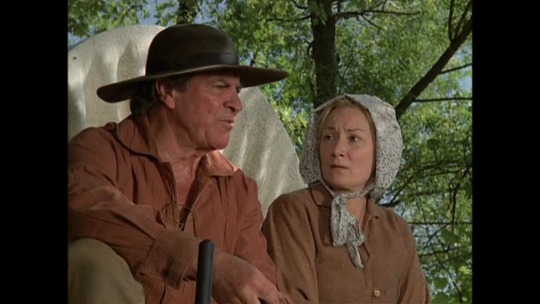
"THE CHISHOLMS" (1979): CHAPTER I Commentary
Years ago, before the advent of DVDs, I had perused my local video rental store for something to watch. I came across a miniseries called "THE CHISHOLMS". Due to it being a Western and possessing a running time of four hours and thirty minutes, I decided to give it a chance. I managed to purchase a VHS copy of the miniseries and enjoy for several years. But with the advent of the DVD and my VHS player going on the blink, I had to wait quite a while before I could finally get a DVD copy of it.
Based upon Evan Hunter's 1976 novel, "THE CHISHOLMS" told the story of a family from western Virginia, who make the momentous decision to travel west to California after losing part of their farm to a neighbor, due to some unusual circumstances. Unlike many other television and movie productions about the westward migration during the 1840s, "THE CHIISHOLMS" took its time in setting up the story. In this first episode, it spent at least an hour introducing the Chisholm family - namely:
*Hadley Chisholm - the family's patriarch and owner of a farm in western Virginia
*Minerva Chisholm - the family's matriarch
*William "Will" Chisholm - Hadley and Minerva's oldest son, who is also a veteran of the Texas Revolution
*Gideon Chisholm - Hadley and Minerva's second son
*Bonnie Sue Chisholm - Hadley and Minerva's older daughter and Beau's twin
*Beau Chisholm - Hadley and Minerva's youngest son and Bonnie Sue's twin
*Annabel Chisholm - Hadley and Minerva's younger daughter and youngest offspring
The first episode or Chapter I began with Will's wedding to a young local woman named Elizabeth during the spring of 1843. Also, the family is unaware of Bonnie Sue's romance with a young man named Brian Cassidy. Unfortunately for her and Brian, the Chisholms and the Cassidys have been engaged in a feud ever since Hadley's brother had rejected Brian's aunt at the wedding altar several decades ago. When the latter died, the Chisholms and the Cassidys discovered that she had received a portion of the Chisholm land - the farm's most fertile - from Hadley's brother as compensation for being dumped. She never revealed this to her family or the Chisholms. But she did leave her land to her brother and Brian's father, Luke Cassidy, who did not wait long to demand that the Chisholms hand over the land. Matters worsen for the Chisholms when Will's bride die from an infection after giving birth to an unborn child.
With no fertile land to farm, Hadley Chisholm decides to pack his family and migrate to California. Most of the family agrees with his decision, except Minerva, who is reluctant to leave Virginia; and Bonnie Sue, who is reluctant to leave Brian. The journey west goes without a hitch, until the family reaches Louisville, Kentucky. There, they discover from a young Western guide named Lester Hackett that they had departed Virginia at least a month or two late for the journey to California. The family had reached Louisville in mid-May 1844, around the time when most emigrant wagon trains usually departed Independence, Missouri. Upon learning this, Hadley changes his mind about the journey to California and decides to return to Virginia. But Will informs him that there are other members of the family are willing to utilize Lester's plan that would eliminate some time from their trip to Independence. After the Chisholms decide to continue west via a family vote, they utilize Lester's plan by boarding a flat-bottom boat that takes them to Evansville in western Indiana, cutting off their journey by a few weeks.
Some people might find the first hour of "THE CHISHOLMS" rather hard to endure. Most movie and television productions usually spend at least fifteen minutes in introducing its characters and conveying the reasons behind their decision to migrate to the West. "THE CHISHOLMS" spent an hour. Personally, this did not bother me, for I found the circumstances behind the Chisholms' decision to head for California rather interesting. Especially since the circumstances involved a potential feud with another family. Other reasons why I rather enjoyed the miniseries' first hour was how the circumstances in which the family made its departure originated with Hadley Chisholm's displeasure over the neighborhood's new minister from Vermont and how the latter conducted Elizabeth Chisholm's funeral. I would explain how Hadley's conflict over the new minister led to the family sneaking away from their home in the middle of the night. But it would require a great deal of narration on my part. And honestly, I would suggest that you simply watch the miniseries.
Once the family hit the road for California, the miniseries went into full steam. Chapter I only followed the Chisholms from Virginia to southwestern Indiana, but a good deal happened in that half hour. The temptation to return home to Virginia hovered over the family all the way to Louisville. And when the family learned from Lester Hackett that they had left Virginia about a month or so too late, even Hadley was tempted to turn around. What I found interesting about this turn of events is that Chisholms' decision on whether to return to Virginia or continue west to California depended upon a family vote . . . and the instant attraction between Bonnie Sue Chisholm and Lester. Personally, I would have ended Chapter I with that scene inside a Louisville stable. Hadley and Minerva's willingness to decide the whole matter on a vote, along with the sexual attraction between Bonnie Sue and Lester, would end up producing major consequences later in the miniseries and in the short-lived television series that followed. Instead, the Chisholms experienced a brief journey down the Ohio River on a broad horn (flat-bottom raft), while Minerva endured the unwanted attention of the broad horn's captain (or patroon) named Jimmy Jackson. By the time the family reached the outskirts of Evansville, they had reached the point of no return.
Another aspect about "THE CHISHOLMS" that I enjoyed, was how the producers, director Mel Stuart and the screenwriters utilized the production's historical background without hitting viewers over the head with facts. The family had departed Virginia in 1844, a year that featured a Presidential election. Not once did the topic of the election graced anyone's lips. But the miniseries made it clear that Will Chisholm was a veteran of the Texas Revolution of 1836. The miniseries also brought up the topic of slavery. The narrative pointed out that Hadley's wealthiest neighbor was a planter and slave owner. And during the last half hour of Chapter I, a coffle of slaves was among the other passengers aboard Jimmy Jackson's broad horn, leading Minerva Chisholm to express anti-slavery sentiments. I also enjoyed how the miniseries gave television viewers a lengthy peek into life in the early-to-mid 19th century Appalachia. I have always admired Aaron Copeland's score for the miniseries. But I must admit that his score contributed to this episode's first hour, which featured the Chisholms' life in western Virginia.
Most of the production's historical background seemed to revolve around the family's westward journey. Unlike many Hollywood productions, television viewers did not see the Chisholms' wagon being pulled by horses (which is historically inaccurate). And the narrative went out of its way to point out that the family had started its westbound journey about a month or two late. I also enjoyed the brief montage that featured the Chisholms' early start on the journey and what it took for them to maintain supplies and keep their wagon in condition. Steven P. Sardanis's production designs, the art direction that he provided with Fred Price, Charles Korian and Charles B. Price's set decorations, and Tom Costick's costumes (to a certain extent), did a great job in re-creating western Virginia and the Ohio River Valley circa 1844.
But in the, the cast proved to be the best thing about "THE CHISHOLMS". I must commend casting director Vicki Rosenberg for gathering a first-rate collection of performers for the cast. The miniseries featured solid performances from Dean Hill, Jack Wallace, Maureen Steindler, Tom Taylor, James O'Reilly and Gavin Troster; even if they did not exactly rock my boat. Glynnis O'Connor gave a charming performance as Will's young wife, Elizabeth Chisholm. Anthony Zerbe gave a spotless performance as the sleazy flat boat patroon, Jimmy Jackson. But the one supporting performance that caught my eye came from Charles Frank, who gave the first of a series of dazzling performance as the charmingly ambiguous Lester Hackett.
Rosenberg casting of the Chisholm family proved to be even more impressive to me. Susan Swift gave a very charming and balanced performance as the family's youngest member, Annabel Chisholm, who seemed divided between the adventure of migrating to California and being mindful of her mother's reluctance to move. James Van Patten gave a very energetic and intense performance as the family's hot-tempered member, Beau Chisholm. Stacy Nelkin's portrayal of the sensual, yet pragmatic Bonnie Sue Chisholm struck me as very skillful, which is why her performance was one of my favorites in the series. Brian Kerwin, whom I remember from the 1982 miniseries, "THE BLUE AND THE GRAY", seemed a bit laid back as middle son, Gideon Chisholm. But he gave a charming performance in the end. Ben Murphy portrayed the oldest sibling, Will Chisholm. And I thought he did a great job in revealing how Will seemed to be an interesting combination of his parents. I was especially impressed by how he handled Will's grief over Elizabeth's death.
Years after I had first seen "THE CHISHOLMS", I was surprised to learn that the two leads - Robert Preston and Rosemary Harris - had first worked together on the 1966 Broadway play, "THE LION IN THE WINTER". I do not know if having them reunite for the 1979 miniseries was Rosenberg or someone's idea, but it was a damn good one, all the same. What can I say? Whatever magic Preston and Harris had created on Broadway back in the mid-1960s, they managed to re-create it front of the television camera some 12 to 13 years later. In some ways, the pair seemed like the yin and yang of the Chisholm family. They were so perfect together that I do not know how else to describe their performance.
Before I end this article, I must admit there were one or two aspects of "THE CHISHOLMS" that either did not impress me or . . . confused me. Although I believe that Tom Costick's costumes added to the production mid-1840s setting . . . but only to a certain degree. It did seem that a great deal of Costick's costumes looked as if they had come out of a Hollywood warehouse, instead of being created by him. Especially the women's costumes. Even those costumes worn by well-to-do women in the Louisville sequence gave that impression. And I am a little confused about the circumstances surrounding Hadley's loss of his most fertile cornfield. I understood how he lost the actual land to Luke Cassidy. What I did not understand was how Cassidy managed to take possession of the corn that the Chisholm family had already sown. Surely the court would have allowed the Chisholms to profit from the corn sown from seeds purchased by them? If someone could clear this matter for me, please do so.
Despite my quibbles regarding the costumes and the matter surrounding the cornfield lost to the Chisholms, I enjoyed Chapter I of "THE CHISHOLMS" very much. In fact, watching it reminded me why it had become one of my favorite miniseries in the first place. Why on earth did I wait so long in watching it again? Oh well . . . on to Chapter II.
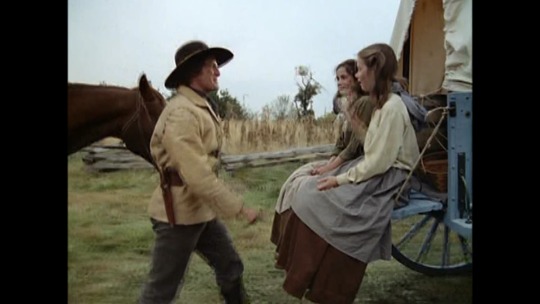
#the chisholms#evan hunter#westward expansion#literary#period drama#period dramas#costume drama#antebellum#robert preston#rosemary harris#ben murphy#brian kerwin#james van patten#stacy nelkin#susan swift#glynnis o'connor#charles frank#anthony zerbe
0 notes
Photo
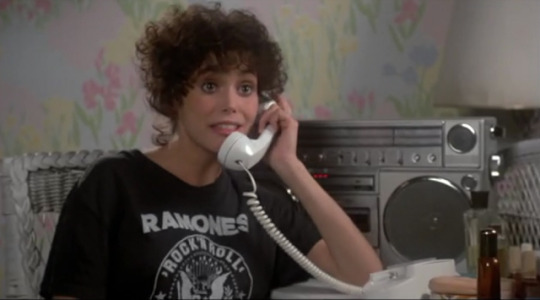

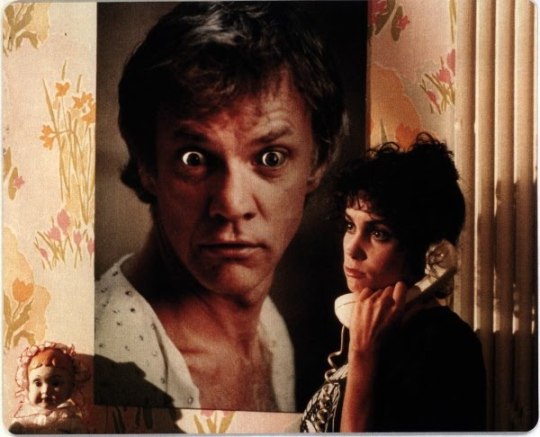
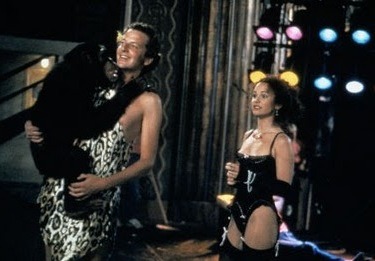




THE GREATEST FILMS EVER MADE: “GET CRAZY” (1983)
#get crazy#malcolm mcdowell#lee ving#fear#stacy nelkin#daniel stern#gail edwards#allan arkush#lou reed#sparks#80's cult comedies#80's comedies#80's post punk#new wave#post punk#punk rock#80's L.A. punk#80s hardcore punk#the ramones#rock n roll high school
19 notes
·
View notes
